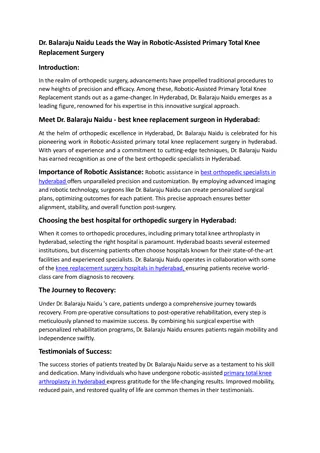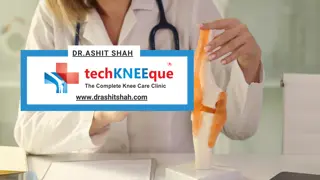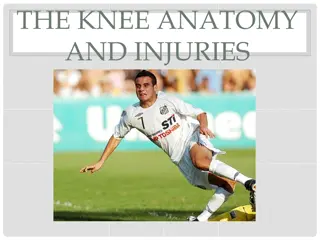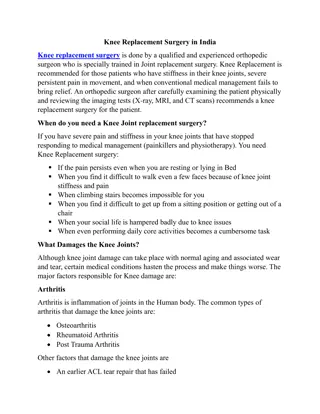Comprehensive Guide to Knee Joint Replacement Surgery
Explore the detailed journey of knee joint replacement surgery, covering the surgical process, recovery expectations, possible complications, knee anatomy overview, types of arthritis, knee compartments, and surgical treatments for partial and total knee replacements. Gain insights into why and how the surgery is performed and learn about the role of ligaments, cartilage, and bone structures in the knee. Understand the distinctions between partial and total knee replacements based on arthritis severity and affected compartments.
Download Presentation

Please find below an Image/Link to download the presentation.
The content on the website is provided AS IS for your information and personal use only. It may not be sold, licensed, or shared on other websites without obtaining consent from the author. Download presentation by click this link. If you encounter any issues during the download, it is possible that the publisher has removed the file from their server.
E N D
Presentation Transcript
Joint Replacement Journey WELCOME TO DR. TAD GERLINGER S JOINT REPLACEMENT EDUCATION CLASS
Class Objectives Understand why and how surgery is performed Understand typical hospital course Understand typical recovery Discuss possible complications and how you and your surgical team can prevent possible complications
Knee Anatomy Overview Femur (thighbone) Tibia (shin bone) Patella (knee cap) Cartilage a smooth tissue that cushions the ends of the bones and enables them to move easily Ligaments Anterior cruciate ligament (ACL) Posterior cruciate ligament (PCL) Medial collateral ligament (MCL) Lateral collateral ligament (LCL)
Knee Anatomy (contd) Arthritis Inflammation and subsequent destruction of cartilage tissue Types of arthritis Osteoarthritis Rheumatoid arthritis Post-traumatic arthritis
Knee Compartments Compartments Medial compartment Lateral compartment Patellofemoral compartment If you have arthritis in only ONE compartment, that would indicate you for a partial knee replacement or Unicompartmental knee replacement. If the arthritis has spread to 2 or more compartments, that would indicate you for a Total Knee Replacement.
Surgical Treatment - Partial Smith & Nephew Implant If one compartment affected by arthritis: Prepare the bone Damaged surfaces removed Position metal implants Metal cemented to bone Insert a spacer Medical grade plastic separates metal surfaces to create smooth gliding surface
Surgical Treatment - Total Smith & Nephew Legion Implant If two or more compartments affected by arthritis: Prepare the bone Damaged surfaces removed Position metal implants Metal cemented to bone Insert a spacer Medical grade plastic separates metal surfaces to create smooth gliding surface Resurface the patella Plastic button applied
Hip Anatomy Overview Femur (thighbone) Pelvis Ball and socket joint Femoral head = ball Acetabulum = socket Cartilage a smooth tissue that cushions the ends of the bones and enables them to move easily
Hip Anatomy (contd) Arthritis Inflammation and subsequent destruction of cartilage tissue Types of arthritis Osteoarthritis Rheumatoid arthritis Post-traumatic arthritis Avascular necrosis Congenital deformities
Surgical Treatment Femoral head (ball) is removed Metal stem inserted into hollow center of femur Press fit vs. cemented Ceramic ball attached to metal stem Damaged surface of acetabulum (socket) is removed and replaced with metal cup A screw is placed Plastic liner Smith & Nephew Anthology, Kyocera or Zimmer Biomet Systems * HIP PRECAUTIONS * For 6 weeks 1. Do not bend greater than 90 degrees 2. Do not twist your surgical leg inward 3. Do not cross your legs
Minimally Invasive Joint Surgery Knee: Incision smaller than traditional 3-5 inches in length vs. 8-10 inches Hip: (Posterior Approach) Incision placed over outside of hip 4-6 inches in length Benefits: Less tissue disturbance Less blood loss Less postoperative pain Faster rehabilitation
Incision: Closures and Dressings Dissolvable sutures and skin glue Aquacel AG dressing Hydrocolloid, latex free Designed to stay in place for 7 days Waterproof Anti-microbial Dressing type #1: Aquacel
Incision: Closures and Dressings (contd) Nylon sutures Removed at 3 week f/u Prevena Incisional Vac Designed to stay in place for 7 days Waterproof Prevents infection Promotes incision healing Disposable (one-time use) Dressing Type #2: Prevena
Post Surgical Dressing Incision Care Aquacel/Prevena is removed 7 days after surgery Peel off like a band-aid and discard everything (including Prevena vac) If no drainage, may leave incision open to air If drainage, or if you prefer, cover with gauze dressing and hold in place with ACE wrap NO TAPE Change daily and as needed OK to shower after surgical dressing is removed Do not cover with saran wrap or subsequent waterproof dressing No baths, pools, hot tubs until cleared by Dr. Gerlinger No creams, lotions, ointments until cleared by Dr. Gerlinger
Anesthesia Knee: Combination spinal/regional anesthesia with twilight sedation Hip: Epidural with Twilight Sedation Wake up easier with less side effects Better pain control Able to get up and move faster General anesthesia if indicated by anesthesiologist **You will meet with the anesthesia team prior to surgery
Oral Hydration for better results! Stay well hydrated 3 days prior to surgery Patient must finish 500mL of Gatorade2 hours prior to scheduled arrival time to hospital. If patient forgets to drink gatorade in time frame, surgery will not be cancelled. This is primarily to aid in your success!
Hibiclens (before surgery) We recommend you wash the surgical area with hibiclens the night before surgery and the AM of surgery. Hibiclens can be purchased at any local drugstore like CVS or Walgreens. Also called Chlorhexidine Gluconate solution Do NOT use hibiclens on surgical incision after surgery.
Hospital & Surgery Center Course Preop Telephone Call Perioperative Care Nurse (business day before surgery) Given time of surgery, when to arrive, when to stop eating/drinking Day of Surgery Rush Medical Center (Inpatient surgery only) Midwest Orthopaedics at Rush Oak Brook Outpatient Center Gold Coast Surgicenter South Suburban Surgical Suites in Indiana Preop/Holding (1-1/2 to 2 hours before surgery)
Hospital Course (contd) Operating Room (1-1/2 to 2 hours) Positioning Surgical Procedure (30 to 45 minutes) Incision Closure Reverse Anesthesia Recovery Room (1 to 2 hours) Last stop for outpatient surgery Orthopedic Floor / 13 East Tower (1-2 days)
Lines, Tubes, Drains Peripheral IV Removed at discharge Sequential Compression Device Decrease risk of blood clots Hemovac Helps decrease pressure on incision Total Knee Replacements only
Discharge Requirements Physical Therapy Stair climbing, gait training, use of ambulatory device Will issue ambulatory device (cane, crutches, walker) at discharge Medically Stable Labs and vital signs must be within normal limits prior to discharge Pain Management Medication scripts sent to pharmacy at discharge
Cold Therapy after Surgery Cold Therapy for your Comfort To help ease your pain and swelling after surgery, you will be given a cold therapy wrap with 2 gel ice packs Each gel pack will remain cold for up to 4 hours Ice at least 4-5 times a day for 20 minutes at a time Ice machines can be purchased through our DME store
Typical Postoperative Pain Management Drug Use Quantity Duration Dose/Frequency Gabapentin Neuropathic/Nerve pain 200mg/ three times a day (6am, 2pm, 10pm) 90 14 days no refills Tylenol* Pain management 1000mg / three times a day (6am, 2pm, 10pm) 90 5-7 days scheduled Tramadol* Pain management 100mg / three times a day (6am, 2pm, 10pm) 42 5-7 days scheduled Meloxicam Anti-inflammatory 15mg / once a day 30 30 days no refills Oxycodone** Pain management 5mg / every 4-6 hours as needed 30 As needed *Please contact office for refills No refills provided after 6 weeks postop **No refills provided after 3 weeks postop
Other Medications Aspirin 81mg twice a day Blood clot prevention May vary depending on medical history Senna-S 8.6/50mg twice a day Stool softener **Cefadroxil 500mg twice a day Oral antibiotic **Ondansetron 4mg as needed Nausea **Outpatient surgery only
Physical Therapy Outpatient Physical Therapy in the Home (OPITH) MOR will send a therapist to your home after surgery 2-3 x/week starting 5-10 days after your surgery You will be contacted 2 weeks prior to schedule these in home visits Your therapist will transition you to an outpatient clinic by week 3. Dr Gerlinger recommends one of our MOR PT locations (map on our website) The 1st week: Practice home exercises/stretches taught by the therapist in the hospital Patients may opt out of the OPITH program and start outpatient PT starting 5-10 days post op
Follow Up Office Visits 3 weeks postop Wound check X-rays Nylon sutures removed (if applicable) 6 weeks postop X-rays Annual and as needed Telemedicine visit available upon request
Visits with our Nurse Practioner, Alissa Winner Midwest Orthopaedic Locations Postop follow up appointments Hip or Knee Evaluations Knee Injections To schedule, please contact Dr. Gerlinger s office! Telemedicine available upon request
When Can I Return to work? Light duty/desk job: 2-4 weeks postop Heavy duty/Labor intensive: 6-8 weeks postop Drive? 2 weeks post op research shows your brake reflex is back Must be off pain medications and feel safe Fly? Preferably after 3 week wound check appointment No implant cards anymore- opt to go through scanner at TSA Return to activities/exercise? Typically by 6 weeks 75% recovered, 6 months 100% Ease into activity after 6 weeks Have my other knee/hip replaced? Six weeks between surgeries minimum
Potential Risks and Complications Infection Medically optimized by a RUSH Internist Hibiclens (wash surgical area night before and AM of surgery) Intravenous antibiotics given in hospital Private rooms Short hospital stay Dental prophylaxis Lifelong recommendation for any and all dental procedures Amoxicillin 2000 mg 1 hour before Clindamycin 600 mg 1 hour before (if allergic to penicillin) No dental work 3wks prior to surgery and 3months after surgery Deep Vein Thrombosis / Pulmonary Embolism Anticoagulation medication Early mobilization Hematoma Hemovac Surgical compression dressing
Potential Risks and Complications (contd) Loosening / Failure of Implant Low impact exercises Residual Pain/Stiffness Fracture Nerve Injury Elevated risk for peroneal nerve injury with preoperative valgus (knock knee) deformity Blood Loss Skin tears, blisters, delayed wound healing Clicking Leg Length Discrepancy Insomnia
Symptoms After Surgery When to Call Common Swelling throughout leg Bruising throughout leg Warmth Incision redness Low grade temperatures (< 101.5) ** always feel free to call to discuss Calf pain, swelling, redness Fevers greater than 101.5 Significant drainage Pain uncontrolled with medications Spreading redness
Sign up for Dr. Gerlingers surgery texts Before surgery, text JOIN to 312-340-0700 Follow prompts to enroll Standard messaging & data rates apply See Terms and Conditions: www.mystreamd.com/terms
Optional Nutrition Package Available for Purchase EMN Orthopedic Nutrition Bundle Supports lean muscle mass and wound healing Designed for 2 wks before surgery and 2 wks after surgery Flavors: Vanilla Bean and Decaf Cold Brew To purchase: Please visit one of MOR DME stores or: Emnortho.com Code: gerlinger
What do I do now? How to prepare for your surgery Stop medications as directed by your RUSH Internist Prepare living arrangements as necessary Sign up for surgical texts Start protein supplement (optional) Wash surgical area with Hibiclens Stay well hydrated and eat nutritious meals Relax and know you that you are in good hands!
Thank You Please reach out with any questions! Kelly Murray, RN Alissa Winner, DNP Gerlinger Office 312-432-2429























